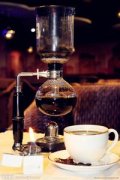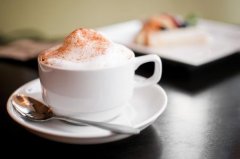Coffee making knowledge the highest level of homemade coffee: hand-made coffee
Hand flushing can bring the personality and characteristics of coffee beans to the extreme, so a single coffee bean is often chosen. Hand-made coffee was invented by the French, but it was the Japanese who carried it forward. Hand brewing is the highest state of coffee brewing. With the support of rich experience, a cup of coffee with great personality can be obtained by controlling water temperature, powder quantity and thickness, flushing speed, technique and extraction time.

The basic appliances required for making coffee by hand are as follows:
Filter cup filter paper filter kettle fine kettle thermometer
Process:
Step 1: origami filter paper.
Fold the filter paper into a cone along the edge of the filter paper seam and put it into the filter cup.
Step 2: wet the filter paper.
Remove the odor of the filter paper with hot water and stick the filter paper to the filter cup
Step 3: grind beans and pour powder.
Pour the ground powder into the filter paper and pat the filter cup to make the coffee powder basically flat.
Step 4: warm the cup and warm the pot.
Pour a small amount of hot water into the bottom pot, shake a few times, and then pour out. Then put the solid bean powder on the bottom pot.
Step 5: prepare 91 degrees hot water.
Step 6: steaming.
Pour water from the center of the powder and circle 2-3 times. Freshly baked coffee powder will expand after absorbing water, protruding upward, emitting a light mellow flavor. At this time, there is basically no water dripping from the filter cup, and it is normal to have 3-5 drops. The purpose of steaming is to let the dry powder absorb water evenly and prepare for secondary water injection.
Step 7: brew.
After more than ten seconds, the water is injected stably with a flow thicker than that of steaming. Pay attention to the flow of water not to rush to the filter paper, otherwise the extraction is insufficient. This step will inject water twice until the required liquid is extracted.
Step 8: fill the cup.
Before filling the cup, you should warm the cup, then gently shake the hand to make the coffee evenly, pour the coffee into the cup and produce it.
The flavor of hand-brewed coffee is soft, bright, smooth and layered, and its sweetness is not inferior. It is famous for its elegant, sweet and sour fragrance.
Important Notice :
前街咖啡 FrontStreet Coffee has moved to new addredd:
FrontStreet Coffee Address: 315,Donghua East Road,GuangZhou
Tel:020 38364473
- Prev

Coffee making skills homemade coffee analysis: siphon pot
Siphon pot (Syphon), commonly known as "glass ball" or "siphon", is a simple and easy-to-use method of coffee brewing, and it is also one of the most popular coffee brewing methods in cafes. Although the siphon pot has the nickname of "plug wind type", it has nothing to do with the siphon principle, but uses water heating to produce water vapor, resulting in thermal expansion and cold contraction principle, push the hot water from the lower sphere to the upper pot, and then wait for the lower pot to cool.
- Next

Peruvian coffee, famous for its organic coffee.
Peruvian coffee, famous for its organic coffee. Peru (Spanish: Per; Quechua, Aymara: Piruw), the full name of the Republic of Peru (Spanish: Repblica del Per), is a country in western South America. Coffee origin: Peru (Peru) is also a major coffee producer. Up to 98% of Peruvian coffee is grown in forest areas, and most producers are
Related
- Beginners will see the "Coffee pull flower" guide!
- What is the difference between ice blog purified milk and ordinary milk coffee?
- Why is the Philippines the largest producer of crops in Liberia?
- For coffee extraction, should the fine powder be retained?
- How does extracted espresso fill pressed powder? How much strength does it take to press the powder?
- How to make jasmine cold extract coffee? Is the jasmine + latte good?
- Will this little toy really make the coffee taste better? How does Lily Drip affect coffee extraction?
- Will the action of slapping the filter cup also affect coffee extraction?
- What's the difference between powder-to-water ratio and powder-to-liquid ratio?
- What is the Ethiopian local species? What does it have to do with Heirloom native species?

